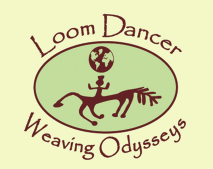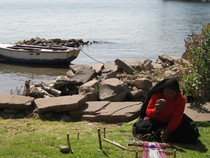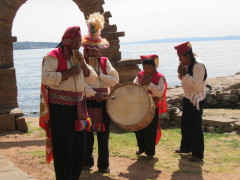Come Experience the Magic of Peru
April 25 - May 5, 2016
SOLD OUT - We would be happy to put you on the waitlist
Be sure to click on the rectangle in the lower right corner for full screen
with Optional Extensions to Lake Titicaca
Click below for a detailed brochure
Adobe Acrobat document [4.6 MB]
Life on Taquile Island
An Ancient Culture on Peru's Lake Titicaca
by Cari Sample Malver
When we climbed out of our small boat onto the shores of Taquile Island, it seemed that we took a step back in time. Two women, shrouded in black shawls covering their heads, sat awkwardly on the ground pounding in sticks to hold their looms. Men sat nearby on a rock wall chatting quietly and knitting intricate hats. The only sounds were the songs of birds and the lapping of the water on the rocks along the shoreline. What a privilege to witness this scene with its air of ancient mystery and the snow covered peaks of Bolivia as a backdrop.
Located 45 km offshore from the high Andean city of Puno, on the Peruvian side of Lake Titicaca, this small idyllic island is a time capsule of the remarkably preserved cultures of Peru and Bolivia. Life here has largely remained the same for thousands of years. No cars, no hotels and no electricity mar the peace and tranquility of this haven. The men are devoted to the agriculture and the fishing, and the women to the weaving. The approximately 3,000 inhabitants still live their lives by the Inca moral code ama sua, ama llulla, ama qhilla, (Quechua for "do not steal, do not lie, do not be lazy").
Taquile is a beautiful and hilly paradise set in the giant azure Lake Titicaca, which is the highest navigable lake in the world. The highest point of the island is 13,287 feet (4,050 meters) above sea level. It is remarkable how the indigenous people have adapted to this extreme altitude. The inhabitants, known as Taquileños, are southern Quechua speakers and are known for their very special culture. Their handwoven textiles and finely knitted hats are considered some of the highest quality handicrafts found not only in Peru, but in the entire world. Only the men on the island knit and often begin learning the craft at age eight. The women are the weavers on the island creating exquisite works.
The clothing on the island is as unique as its people. The color of each garment and hat carries a different significance. For example, social status is defined by their clothing. The community leaders wear black chullos (caps). Married men wear red hats while single men wear red and white caps. Every woman wears a black shawl. Bright tassels signify that the woman is single, while the tassels worn on the shawls of married women are less colorful and prominent.
One of the unique textiles woven by the women of Taquile is the “calendar belt.” There are 12 scenes/symbols on the narrow weaving that signify the activities of the different months and seasons. Intricately created designs depict everything of importance in their lives including planting, fishing, home repairs, and the joy of family returning for the holidays. Often, a man will join his belt\ with that of his wife’s when they marry representing their unity.







